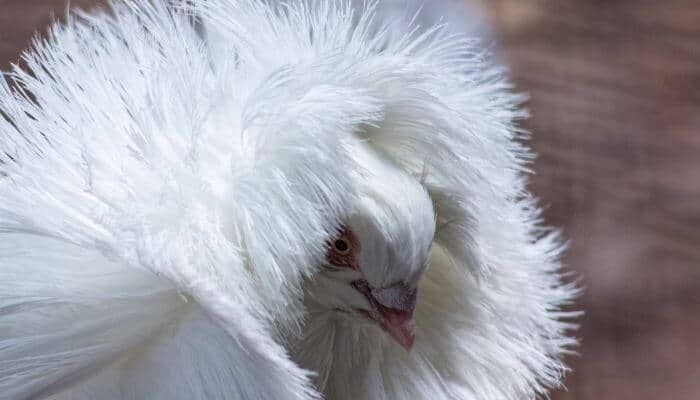A breed of fancy pigeon, they are like all pigeons, a descendant of the Columba Livia, the Rock pigeon.
The Jacobin Pigeon is best known for the feathered hood it displays over its head that breaks down into three parts called the hood, the mane and the chain.
Origins Of The Jacobin Pigeon
They are believed to originate from India through selective breeding and were first bred in the 1500s, Jacobins come with varying sizes of head plumage.
They often live for as long as 15 years, however they can be tricky to look after and so should be handled by enthusiasts rather than people looking for a pretty pet.

During the reign of James the 1st, there were Dominican monk friars that were called Jacobins after the nearby church of St Jacques in Paris.
The British popularised this bird found in India and named them Jacobins because they had feather arrangements on their heads that looked similar to the hoods the Jacobin monks wore. The Old Dutch Capuchine Pigeon is a similar hooded breed.
Selective breeding for the bird started in India as early as the 1500s, but documents show that the bird’s appearance went through four stages, with the fourth stage being the one we see today.

The price of the bird varies, though they are on the pricier side, and are often very expensive if imported from another country.
The elevated price is because the birds only lay around two eggs per clutch and will perhaps lay three batches per season.
Plus, fostering is required, which is why this pigeon breed doesn’t make a good pet and is best left to enthusiasts and experts.
Its show group is the Asian feather and voice pigeon group.
Jacobin Pigeon Appearance
A slender and tall bird, the Jacobin is a medium-sized fancy pigeon.
Different colours seem popular in different countries, with the Australian black, white, red and yellow being popular, though the white with black-tipped feathers are also popular.
Its fluffy feathers make it look a little more robust than it actually is.

The bird is rather slender and tall, with a distinctive muff or cowl of feathers that form a rosette on both sides of the pigeon’s head.
This is made up of a mane that runs down the back of the bird’s head, two lines of feathers that run down the front of the bird’s chest, and a hood over the top of the bird’s head.
Longer necked birds are in fashion because it shows off the hood a little better.
However, genetically, it seems that the heavily shouldered birds are more likely to have better feather quality.
The Jacobin bird doesn’t have feathers covering its feet, just a small amount of fluffy feathers at the top of the leg.
The Muff or Cowl
Despite looking nice, the bigger and fluffier the cowl or muff, the worse parent the bird is simply because it has a hard time seeing its eggs and its young.

In fact, you may find yourself pushing an egg back into the nest because the bird hasn’t seen it slip away.
Its poor parenting and the risk of bird disease spread is the reason why fostering is often required for fledgling or baby Jacobins.
Breeding Jacobins
Genetically, the birds are pretty uniform. In other words, if you breed two similar-looking birds, you will get similar looking babies.
Most Jacobin prefer to breed around the end of July, or near the middle-to-end of summer depending upon which country you are in.
The cowl or muff may become a problem, which is why some breeders trim the feathers around the head to help mating.
A mated female will lay an egg and then wait around a day before laying another. It then takes roughly seventeen days for the eggs to hatch.
The cowl and short beak make feeding the babies difficult, which is why the birds are often fostered out to another more suitable pigeon.
Aim for a maximum of three batches of eggs per season.
Trying for more will put a serious strain on the bird.
Breeders often sell their breeding birds after six years of age because the males become less promiscuous, and the females slow their egg-laying down to a halt.
However, the birds still have plenty of life left in them with most living to the age of ten, so are still viable for sale to people who want a lower-priced fancy pigeon for their collection.
Jacobins Character
Females and males often need their own area to breed because they are often very individualistic.
Also, if you have several birds, one of the males may take over the cage floor and call it his territory, then attacking other birds as they try to feed.
It is a quarrelsome bird that is not aggressive to humans but doesn’t make a good pet because it is not affectionate.
The females are easier to get along with, especially if you have children and you wish to introduce them to the world of pigeon keeping.
If you are keeping them as pets, then the males are more entertaining to watch since they are not above randomly irksome behaviour.
